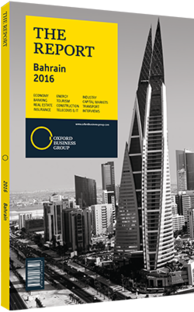Equities
The Bahrain Bourse (BHB) was established in 1987 and commenced operations in 1989, with only two stocks trading. Since then, the bourse has grown to include 46 common stocks (including two closed for trading, and two non-Bahraini companies listed on the exchange), government bonds and mutual funds. The market is serviced by 12 brokers, of which three are individuals. Securities and Investment Company (SICO) is the largest broker in the kingdom.
According to Bloomberg, the market capitalisation of the Bahrain Index (BHSEASI) stood at $17.1bn at the end of October 2015. The index – a capitalisation-weighted index of all Bahraini public companies – is dominated by banking and financial services firms that constitute nearly 72% of the total index weight. Ahli United Bank, with a market capitalisation of $4.4bn, is the largest listing on BHSEASI. The index, down 12.4% year-to-date as of end October, has been the second-worst performer in the GCC after Saudi Arabia, as markets began pricing in the second-order effects of the drop in oil prices. However, year-on-year, Bahrain has been the second-best performer in the GCC (behind Abu Dhabi), declining only 13% while the S&P GCC has lost 26%.
Liquidity Issue
Low liquidity has been the primary concern of market participants, even as valuations appear attractive. The annualised six-month average daily traded value (ADTV) stood at BD108m ($284.5m) at the end of October 2015, which was the lowest in the GCC – less than half the 2008-11 median of BD269m ($708.7m), and broadly similar to the levels seen in 1H 2011. The ADTV-to-market capitalisation ratio stands at 1.5%, followed by Kuwait at 13.8%, and a fraction of Saudi Arabia at circa 88%.
The trend is in part due to large long-term holdings of strategic stakeholders or government institutions in major BHB companies, which limits float in these names. According to Bloomberg, some of the largest stocks on the exchange have extremely low free floats – 10% in the case of Aluminium Bahrain, circa 11% for Arab Banking Corporation and 7% for United Gulf Bank; with these names cumulatively accounting for nearly 21% of total exchange weight. Additionally, attractive dividend yields have supported trading inertia among retail investors, given the strong appetite for yields in the region. Bahrain’s average 2014 dividend yield of 5.1%, at current prices, is the highest in the GCC, while its 2015 price-to-earnings (PE) ratio, at 8.5x according to SICO Research, is the lowest. Notwithstanding a 1 percentage point higher return on equity, Bahrain’s PE valuations are at a 38% discount to the Kuwaiti market, where the ADTV is over 45x that of Bahrain. The implication is that investors are potentially pricing in a large liquidity discount, given the challenges in building in and exiting large positions without market impact.
Thus, measures to improve liquidity on the bourse could generate a positive feedback loop, whereby a reduction in bid-ask spreads would serve to reduce the liquidity discount, improve market valuations, generate trading interest and, over a period, incentivise initial public offerings (IPOs). Bahrain’s IPO history has so far been muted, with only two listings since the beginning of 2009 (Alba in 2010 and Zain in 2014).
This contrasts with nine on the Muscat bourse and 18 on the Saudi Stock Exchange during this period.
The BHB has moved a step forward to address this issue. New rules implemented on September 1, 2014 permitted margin trading in securities, reduced the number of exceptional cases from 16 to four, and included exchange-traded funds and real estate investment trusts (REITs) within the ambit of “securities” as defined by the exchange. The potential listing of Bahrain’s first REIT by Eskan Bank is a leap forward in terms of diversifying the market for local exchange-traded securities. The impending IPO of port operator APM Terminals is also likely to be watched closely. Its success could trigger more primary issues.
You have reached the limit of premium articles you can view for free.
Choose from the options below to purchase print or digital editions of our Reports. You can also purchase a website subscription giving you unlimited access to all of our Reports online for 12 months.
If you have already purchased this Report or have a website subscription, please login to continue.

